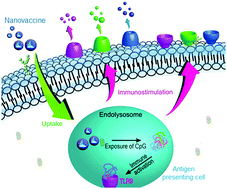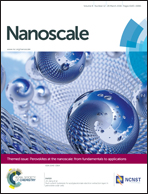DNA–inorganic hybrid nanovaccine for cancer immunotherapy†
Abstract
Cancer evolves to evade or compromise the surveillance of the immune system, and cancer immunotherapy aims to harness the immune system in order to inhibit cancer development. Unmethylated CpG dinucleotide-containing oligonucleotides (CpG), a class of potent adjuvants that activate the toll-like receptor 9 (TLR9) located in the endolysosome of many antigen-presenting cells (APCs), are promising for cancer immunotherapy. However, clinical application of synthetic CpG confronts many challenges such as suboptimal delivery into APCs, unfavorable pharmacokinetics caused by limited biostability and short in vivo half-life, and side effects associated with leaking of CpG into the systemic circulation. Here we present DNA–inorganic hybrid nanovaccines (hNVs) for efficient uptake into APCs, prolonged tumor retention, and potent immunostimulation and cancer immunotherapy. hNVs were self-assembled from concatemer CpG analogs and magnesium pyrophosphate (Mg2PPi). Mg2PPi renders hNVs resistant to nuclease degradation and thermal denaturation, both of which are demanding characteristics for effective vaccination and the storage and transportation of vaccines. Fluorophore-labeled hNVs were tracked to be efficiently internalized into the endolysosomes of APCs, where Mg2PPi was dissolved in an acidic environment and thus CpG analogs were exposed to hNVs. Internalized hNVs in APCs led to (1) elevated secretion of proinflammatory factors, and (2) elevated expression of co-stimulatory factors. Compared with molecular CpG, hNVs dramatically prolonged the tissue retention of CpG analogs and reduced splenomegaly, a common side effect of CpG. In a melanoma mouse model, two injections of hNVs significantly inhibited the tumor growth and outperformed the molecular CpG. These results suggest hNVs are promising for cancer immunotherapy.


 Please wait while we load your content...
Please wait while we load your content...